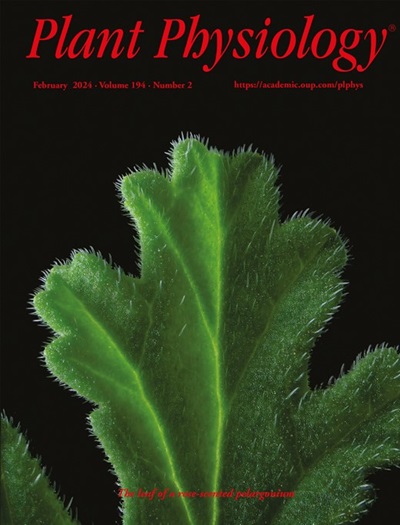转录因子NOR-like1、NAC-NOR和MADS-RIN调控番茄果实成熟的综合模型
IF 6.9
1区 生物学
Q1 PLANT SCIENCES
引用次数: 0
摘要
番茄(Solanum lycopersicum)果实的成熟涉及到更年期乙烯的产生、番茄红素的积累、质地的软化和风味的增强,这是一个高度协调的过程,伴随着深刻的基因表达变化。为了构建成熟调控的综合模型,我们研究了NON-RIPENING- -like1 (NL1)、NON-RIPENING (NAC-NOR, NOR)和ripening INHIBITOR (MADS-RIN)敲除等位基因组合对成熟表型和相关基因表达变化的影响。因此,我们证明了假定的旁系转录因子基因NL1和NOR的产物通过乙烯的产生共同协调成熟的开始和进展。NL1,或其诱导的乙烯产生,与NOR一起,刺激转录因子MADS-RIN的基因表达,然后成为本文研究的所有成熟过程的主要驱动因素。NOR,特别是NL1,对起始后的成熟进程有相对较小但可识别且明显不同的定量贡献。因此,该综合模型建立了调控果实成熟开始和进展的基因表达事件的层次结构。本文章由计算机程序翻译,如有差异,请以英文原文为准。
A comprehensive model of tomato fruit ripening regulation by the transcription factors NOR-like1, NAC-NOR, and MADS-RIN
Tomato (Solanum lycopersicum) fruit ripening involves climacteric ethylene production, lycopene accumulation, texture softening, and flavour enhancement, a highly coordinated process accompanied by profound gene expression changes. To construct a comprehensive model of ripening regulation, we studied the effects on ripening phenotypes and underlying gene expression changes in combinations of knockout alleles of NON-RIPENING- -like1 (NL1), NON-RIPENING (NAC-NOR, NOR), and RIPENING INHIBITOR (MADS-RIN). Thus, we demonstrated that the products of the putative paralogous transcription factor genes NL1 and NOR together orchestrate ripening initiation and progression through ethylene production. NL1, or the ethylene production that it induces, together with NOR, stimulates the gene expression of transcription factor MADS-RIN, which then becomes the major driver of all ripening processes studied here. NOR and, particularly, NL1 have relatively minor but discernable and clearly different quantitative contributions to the ripening progression after initiation. Thus, the comprehensive model establishes a hierarchy of gene expression events regulating the start and progression of fruit ripening.
求助全文
通过发布文献求助,成功后即可免费获取论文全文。
去求助
来源期刊

Plant Physiology
生物-植物科学
CiteScore
12.20
自引率
5.40%
发文量
535
审稿时长
2.3 months
期刊介绍:
Plant Physiology® is a distinguished and highly respected journal with a rich history dating back to its establishment in 1926. It stands as a leading international publication in the field of plant biology, covering a comprehensive range of topics from the molecular and structural aspects of plant life to systems biology and ecophysiology. Recognized as the most highly cited journal in plant sciences, Plant Physiology® is a testament to its commitment to excellence and the dissemination of groundbreaking research.
As the official publication of the American Society of Plant Biologists, Plant Physiology® upholds rigorous peer-review standards, ensuring that the scientific community receives the highest quality research. The journal releases 12 issues annually, providing a steady stream of new findings and insights to its readership.
 求助内容:
求助内容: 应助结果提醒方式:
应助结果提醒方式:


